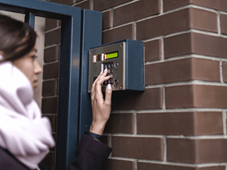To Improve Physical Security, Start at the Switch
 By Craig Thomson | December 11, 2019
By Craig Thomson | December 11, 2019

Designing effective switches starts with understanding people.
The design process follows a simple, clear pattern: Define the problem, conceive an idea to address it, craft a prototype, and then build and test it. Knowing human behavior is the launch point for the entire process.
Understanding people means understanding that people treat devices badly. Computer frozen? Jab the ‘Enter’ key incessantly. The snack doesn’t fall after the machine takes the money? Poke E9 until the frustration subsides. The light doesn’t change at the crosswalk? Slam the button again. And again. Even when people aren’t riled, the devices take it on the chin. Finished pumping the gas? Slam the nozzle back into the holder. How long until the elevator arrives? Push the button repeatedly this time.
Imagine what devices must withstand when they are part of a physical security system that criminals are seeking to penetrate or vandals are aiming to abuse. Switches designed to withstand punishment from humans are always of value no matter what their application. But switches absolutely must be tougher than the rest when they are designed for physical security systems.
Across the workplace spectrum, cybersecurity is the red-hot topic of the moment. Worldwide spending on cybersecurity will swell 8.7% to $124 billion this year, up from $114 billion in 2018, according to Gartner, the Connecticut-based global research and consulting giant. A Gartner survey pointed to three common-sense factors driving this trend: Security risks, which are increasing exponentially; business needs as companies continue the digital transformation; and industry changes in the constantly evolving work climate.
“Security and risk management has to be a critical part of any digital business initiative,” said Gartner Research Director Siddharth Deshpande.
Of course, no security program is complete without physical security. This is not limited to securing a given site but also extends to guarding against damage, whether from professional or lifelong criminals or merely the impatient.
That all leads back to switches. The modest electromechanical actuators that enable human beings to interface with machines gain access to buildings or secure a property bear the brunt of the security burden. The importance of the switch often goes unnoticed because of the workaday nature of their place in things secure. But, it’s here that an industrial designer that understands human behavior will seek out and incorporate switches that are up to the task. In our modern, automated, electronically measured world, the opportunities for considering “the right switch” abound. Consider these essential types in the realm of physical security:
Pushbuttons: It seems we encounter pushbuttons at every turn throughout the course of our day. They facilitate access to the gas pump after we’ve entered the zip code associated with our credit card, or disarm the alarm as we enter our homes. Pushbuttons can provide an array of functions, including detecting potential duress and thwarting activities of criminals looking to breach doors and gates to restricted areas. These applications are rigorous and demand that pushbuttons are sealed against the elements, able to withstand impacts and guaranteed to work.
Key operated switches: Operated by keys, these switches are frequently used for facilities with automatic gates, in accordance with common local regulations and requirements of utility companies. Key switches come in two primary types: switch locks and mortise key switches. Risks can run high with key switches, though, as savvy criminals can easily bypass all but those of the highest quality.
Magnetic switches: This type of switch has been in existence for nearly half a century. Commonly it is seen on doors and windows as part of security systems. While vulnerabilities abound for these types of switches in traditional physical security applications, they play a critical role in ensuring safety through other uses. Magnetic switches help ensure that airport jetway operators have correctly aligned the jet bridge with the aircraft. They are also used for signal switching in high voltage relays, controlling voltage in welding gear, and confirming that gas pump handles have been safely returned to the cradle.
These examples make it clear that high-performing, high-quality switches play a huge role to ensure any number of security products are going to work. There is no room for failure when it comes to a product’s ability to withstand the extreme rigors of physical security. This is why the human impact on switches must be considered in every product design to ensure physical security systems continue to do what they do best – thwarting the worst intentions of intruders of every stripe, from season criminals to senseless vandals. After all, security does start with the switch.
